











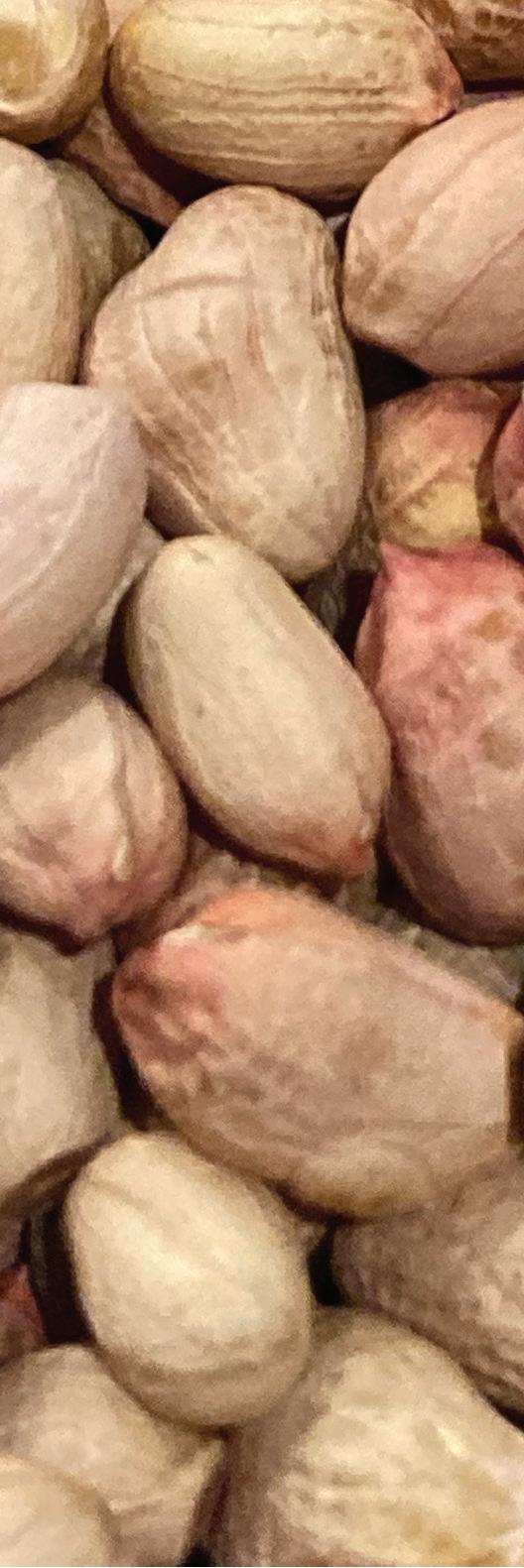








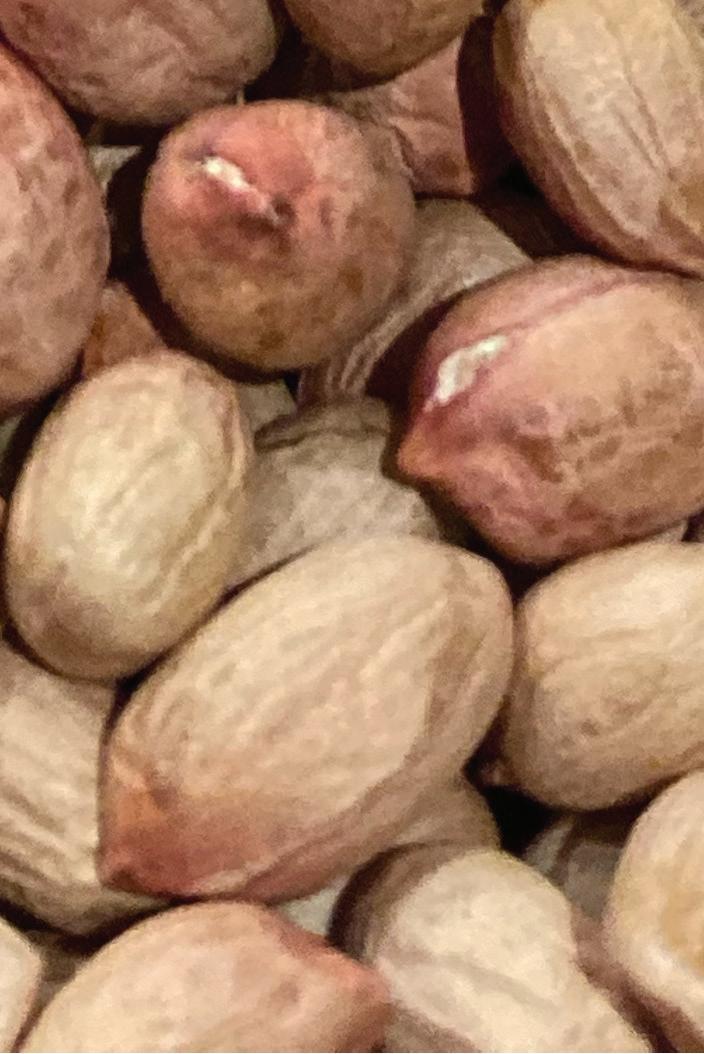





































We know you’re busy with more important things, so we’ll get to the point. The U.S. Postal Service requires that we receive a written request from you to continue sending The Peanut Grower for FREE.
Please take a few moments to renew online by scanning the QR code. We don’t want to lose you as a reader.

















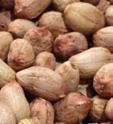

















EDITORIAL/PRODUCTION
Editor Amanda Huber ahuber@onegrower.com
Copy Editor
Cassidy Nemec cnemec@onegrower.com
Art Director Ashley Kumpe
Digital Content Manager Katie Guthrie
ADMINISTRATION
Publisher/Vice President
Lia Guthrie (901) 497-3689 lguthrie@onegrower.com
Associate Publisher/Editor-In-Chief Carroll Smith (901) 326-4443
Associate Publisher/Sales Scott Emerson (386) 462-1532 semerson@onegrower.com
Audience Services
Kate Thomas (847) 559-7514
Production Manager David Boyd dboyd@onegrower.com
For subscription changes or change of address, call (847) 559-7578 or email peanutgrower@omeda.com
Scott Monfort
Extension Agronomist
University of Georgia
Dell Cotton
Peanut Growers Cooperative Marketing Assn., Franklin, VA
Kris Balkcom
Agri-Program Associate
Auburn University
Dan Anco
Extension Peanut Specialist
Clemson University
Emi Kimura Extension Agronomist Texas A&M University David Jordan Extension Agronomist North Carolina State University Glen Harris Extension Agronomist University of Georgia Jason Ferrell Extension Weed Specialist University of Florida
Mike Lamensdorf PRESIDENT/TREASURER
Lia Guthrie PUBLISHER/VICE PRESIDENT
The Peanut Grower (ISSN 1042-9379) is an agribusiness magazine for U.S. peanut producers. Published in eight monthly issues, January through July and November. Annual subscriptions are $40.00. Single Copy price is $5.00. Annual overseas subscriptions are $70.00, including Canada/Mexico. Periodicals postage paid at at Memphis, Tennessee, and at additional mailing o ices. Copyright © 2024 One Grower Publishing, LLC, all rights reserved except where otherwise noted. The Peanut Grower ® is a registered trademark, which reserves all rights granted by the U.S. Patent and Trademark O ice in association with the registration. POSTMASTER: SEND ADDRESS CHANGES TO OMEDA COMMUNICATIONS, CUSTOMER SERVICE DEPARTMENT, P.O. BOX 1388, NORTHBROOK, IL 60065-1388. All statements, including product claims, are those of the person or organization making the statement or claim. The publisher does not adopt any such statement or claim as its own, and any such statement or claim does not necessarily reflect the opinion of the publisher. Printed in the USA.
One Grower Publishing, LLC, also publishes Cotton Farming, Rice Farming, Soybean South and Corn South
One Grower Publishing, LLC
875 W. Poplar Ave., Suite 23, Box 305 Collierville, TN 38017


This month, I continue my talk with National Peanut Board president and CEO Ryan Lepicier.
Q: What is your philosophy on NPBsponsored production research?
Since 2001, we’ve spent more than $45 million on production research, which is critical for the future. To help farmers grow peanuts as efficiently as possible, then we at NPB need to be plugged in to the research community to know what’s going on. For instance, researchers mapped the peanut genome so breeders can now bring in desired, valuable traits from wild species. Donald Chase, Georgia Peanut Commission vice chairman, grew a leaf spot-resistant variety for the first time, and he’s excited about the potential savings in reduced fungicides.
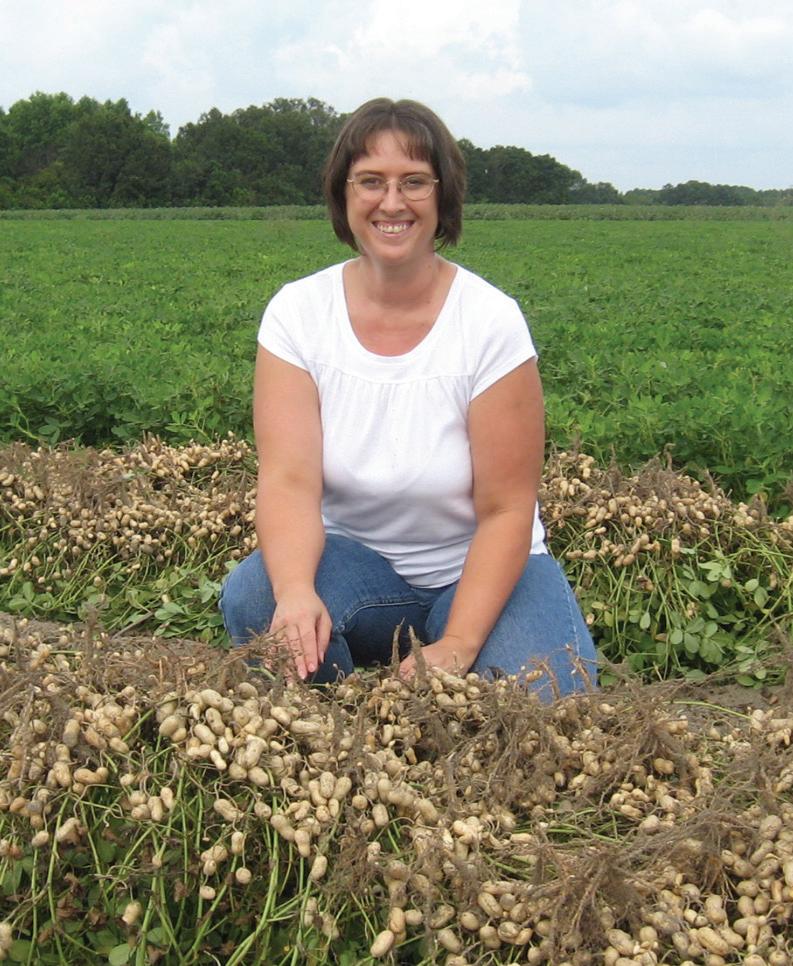 Amanda Huber Editor, e Peanut Grower
Amanda Huber Editor, e Peanut Grower
Cost of production is a serious challenge for growers, so anything we can do on the research side to help alleviate that and bring to the farm varieties that will help with that is good. Research will continue to be a priority, and we will fund it at the same level we have been, which is about 20% of our budget.
Q: Much progress has been made on peanut allergy. What are you excited about on that front?
It’s not unthinkable that we could eradicate peanut allergy in the next 10 to 15 years. With what I see coming down the pike, we have the ability to do that. It may be through a treatment or a cure or a combination of both.
Currently, a vaccine is in testing. There are biologics in use. Drugs used to treat asthma are being considered, and there’s also a toothpaste that can be used to desensitize people to peanut proteins. Recently, a drug used for cancer patients was found by accident when those patients who also had peanut allergy stopped having reactions. There is so much in the pipeline. My prediction is that peanuts will be the first allergen with that type of breakthrough.
We are also changing the way we fund allergy research. We are going to implement a new food allergy research funding program and seek out proposals every year for projects. We will evaluate them with the assistance of outside experts and fund the research we think is most aligned with our priorities, which currently is better diagnostics. We’ve spent more than $36 million on peanut allergy research and education since 2001.
On the consumer side, we will continue to challenge ourselves to deliver cutting-edge marketing to earn consumer attention and inspire action to purchase peanuts and peanut butter.
I think growers can have complete confidence that NPB will move forward with the passion and innovation that’s come to be expected.


Farm groups have met with members of the House and Senate Agriculture Committees in Washington D.C. and urged leaders to raise reference prices in the new Farm Bill since costs of production have surpassed levels approved by Congress eight years ago.
While farm groups have been making their case, a group of U.S. Representatives have written a letter in opposition to any potential increases, saying that any increase would only drive up inflation. U.S. Rep. Alex Mooney (R-WV) was joined by Reps. Andy Ogles (R-TN); Brian Mast (R-FL); Andy Biggs (R-AZ); Carol Miller (R-WV) and Nancy Mace (R-SC) in co-signing the letter.
“At a time when Congress must take steps to reduce federal spending, we must resist costly attempts to expand the scope of government intervention in the free market,” said Rep. Mooney.
The letter was supported by The Club for Growth, Competitive Markets Action and the Council for Citizens Against Government Waste. Their arguments are that these higher-price guarantees mostly benefit fewer than 6,000 farms in a few states, and any increases would benefit less than 0.3% of farming operations. The letter emphasized that increased price guarantees for major crops would mostly benefit farmers of peanuts, cotton and rice in Southern states, not corn and soybean farmers.
U.S. Senator Tommy Tuberville (R-AL) led nine Republican colleagues in sending a letter to leadership of the House and Senate Appropriations Committees slamming the increase in Adverse Effect Wage Rates. Sen. Tuberville and his colleagues are requesting language in an upcoming appropriations package to freeze H-2A wage rates
at the January 2023 levels and reinstate the 14-day delay between the AEWR rate posting and the implementation period. The AEWR increase furthers the financial burdens on employers who utilize the H-2A program.
“The recent 2024 AEWR increase imposes significant financial strains upon employers who utilize agricultural guest workers, yet many employers do not have another option as they depend upon the H-2A program for a reliable workforce,” said the Senators. “As the demand for H-2A labor remains strong, employers who utilize the program generally agree that without additional labor from guest workers, American producers could not efficiently plant or harvest crops.”
Industry supporters of this letter include: American Farm Bureau Federation, National Council of Farmer Cooperatives, International Fresh Produce Association, AmericanHort, North American Blueberry Council, National Cotton Council, U.S. Peanut Federation, USA Rice, National Pecan Federation, Southern Cotton Growers, Southeast Cotton Ginners Association, Alabama Farmers Federation (ALFA), Alabama Nursery & Landscape Association, Alabama Peanut Producers Association and Georgia Fruit and Vegetable Growers Association.
Sen. Tuberville was joined in the letter by Sens. Jim Risch (R-ID), Kevin Cramer (R-ND), Roger Marshall (R-KS), Rick Scott (R-FL), John Cornyn (R-TX), Tom Tillis (R-NC), Mike Braun (R-IN), Ted Budd (R-NC) and Cynthia Lummis (R-WY).
The U.S. Department of Agriculture has announced that agricultural producers can now enroll in the Farm Service Agency’s Agriculture Risk Coverage and Price Loss Coverage programs for the 2024 crop year. The deadline to complete enrollment and make any changes is March 15, 2024.
• Representatives claim change in reference price would benefit few farmers.
• Alabama Senator leads e ort to freeze H2-A wage rate hike.
• Arkansas’ Delta Peanut searches for permanent CEO.
• Peanut Proud Festival turns “Sweet 16” on March 23.
• Class XIII starts Peanut Leadership Academy.
• Growers start the year at farm shows in Tifton, Georgia, and Dothan, Alabama.
“Having the Farm Bill extension in place means business as usual for Agriculture Risk Coverage and Price Loss Coverage program implementation for the 2024 crop year— nothing has changed from previous years,” says FSA Administrator Zach Ducheneaux. “These programs provide critical financial protections against commodity market volatilities for many American farmers, so don’t delay enrollment. Avoid the rush and contact your local FSA office for an appointment because even if you are not changing your program election for 2024, you still need to sign a contract to enroll.”
ARC and PLC are part of a broader USDA safety net that also includes crop insurance and marketing assistance loans. Producers are reminded that ARC and PLC elections and enrollments can impact eligibility for some crop insurance products. Producers on farms with a PLC election can purchase a supplemental coverage option through their approved insurance provider; however, producers on farms where ARC is the election are ineligible for the supplemental coverage option on their planted acres for that crop on that farm.



Greg Baltz of Pocahontas, Arkansas, was recently elected the 2024 National Peanut Board chairman. Baltz’s tenure has included roles as vice chairman, treasurer and secretary. Baltz and his wife Mary Nell own and operate Running Lake Farms and have been growing peanuts for 13 years. He farms runner peanuts, rice, corn and soybeans.
“I’m honored to hold this position as the chairman of NPB,” Baltz said “and am humbled by the support of the Board. My approach will be to make certain that NPB never skips a beat in advancing its mission to improve the economic condition of U.S. peanut farmers and their families through compelling promotion and groundbreaking research. My commitment as chairman is to work alongside our new President and CEO Ryan Lepicier and his staff to achieve these goals.”
The Baltzes have been married for 45 years and have three married children pursuing their own successful careers.
Baltz graduated from the University of Arkansas with a degree in agricultural engineering. He serves on the University of Arkansas College of Engineering Dean’s Advisory Council, as well as the Division of Agriculture Rice Processing Program. He is a current member and former county president of Farm Bureau, and past president of the University of Arkansas Academy of Biological and Agricultural Engineers. Baltz is a former executive officer and member of the Board of Directors of the Knights of Columbus. He is a member of the Arkansas Peanut Growers Association and Black River Technical College Ag Advisory Committee. In their spare time, the Baltzes enjoy traveling.
NPB is made up of farmers whose mission is to improve the economic condition of U.S. peanut farmers and their families through compelling promotion and groundbreaking research.
Early County’s 16th annual Peanut Proud Festival will take place March 23 on the town square in Blakely. The daylong celebration begins with a 5k and Fun Run. Also planned for the festival are a parade, more than 100 vendors, a kids’ peanut butter obstacle course, free entertainment and more. Stop by to sample such delicacies as fried peanuts and grilled PB&J sandwiches. Go to peanutproudfestival.com for more details.
Joe Boddiford, peanut farmer from Sylvania, Georgia, was elected chairman of the Georgia Peanut Commission during the January monthly board meeting. This is Boddiford’s third consecutive term serving as chairman. He previously served as chairman in 2000.
“I look forward to working with Georgia peanut farmers and our industry partners to help enhance the peanut industry and the profitability of farmers,” Boddiford says. “Farmers can contact me at any time if they have suggestions for the work of the Georgia Peanut Commission on their behalf.”
Other officers elected during the board meeting include Donald Chase, Oglethorpe, Georgia, as vice chairman, and Rodney Dawson, Hawkinsville, Georgia, as treasurer. Additional board members include Tim Burch, Newton, Georgia, representing district 1 and Ross Kendrick, Sycamore, Georgia, representing district 2.
The Georgia peanut production area is divided into five districts based on acreage distribution and geographical location with one board member representing each district.
The Georgia Peanut Commission represents more than 4,500 peanut farm families in the state and conducts programs in the areas of research, promotion and education. For more information on the programs of the Georgia Peanut Commission, visit www.gapeanuts.com.
The board of directors for Delta Peanut in Jonesboro, Arkansas, announced recently they have initiated a search for a permanent CEO. Board member and grower-owner, Jeremy Baltz, who has been serving as the Interim CEO, has achieved the objectives he and the board established for his interim role and are now looking forward to adding a permanent CEO to its leadership team.
According to the board, during 2023, the grower-owners planted and harvested Delta Peanut’s largest crop to date. Under Baltz’ leadership, Delta Peanut increased efficiencies and achieved record production levels at our buying points and shelling plant while improving the consistency and manufacturing quality of the peanuts look forward to continuing to be part of Delta Peanut’s success for years to come. Baltz will continue to serve as interim CEO through the transition and will stay on the board of directors, thereafter.
For information, call 870-932-2222 or email info@deltapeanut.com
Twenty-seven peanut growers and sheller representatives from across the Southeast, Arkansas, Texas and the Virginia-Carolina area began Class XIII of the Peanut Leadership Academy Jan. 8-11, 2024, in Savannah, Georgia. The Peanut Leadership Academy is hosted by the Southern Peanut Farmers Federation and is a cooperative effort between Syngenta Crop Protection, the American Peanut Shellers Association and grower organizations. The program began in 1998 with the first class of 14 peanut growers from Alabama, Florida and Georgia. Since then, the academy has grown to include farmers from Arkansas, Mississippi, North Carolina, South Carolina, Texas, Virginia and sheller representatives.
Activities in the leadership program are structured to give participants a thorough understanding of the U.S. peanut industry. Throughout the course of 18 months and five sessions, program attendees participate in sessions ranging



from field trips, meetings with industry leaders and professional development training, as well as one session in Washington, D.C., where class members have an opportunity to visit with members of Congress about issues affecting the peanut industry. During this time, class members build on leadership skills, discuss and debate key industry issues and build relationships.
During the first session, the class members participated in leadership team building skills, etiquette training and learned more about the entire peanut industry while joining the Southern Peanut Farmers Federation annual meeting. Participants in PLA Class XIII include: Cutchin Anderson, Tarboro, North Carolina; Eric Bailey, Waverly, Virginia; Emmanuel Bankston with Golden Peanut; Miles Birdsong with Birdsong Peanuts; Sean Brannen, Statesboro, Georgia; and August Cassebaum of Lillian, Alabama.
Also participating are Jay Corte, Daphne, Alabama; Riley Davis, Parrott, Georgia; Garrett Dixon, Salem, Alabama; Heath Donner, Manila, Arkansas; Trevor Dyer with Sandy Land Peanut; Henry Froese, Seagraves, Texas; Lonnie Gilbert, Marianna, Florida; Chad Harris with Olam; Judson Hornsby, Iron City, Georgia; Douglas Jarrell, Estill, South Carolina; Cason Kirkland with Premium Peanut; Will Krause, Unadilla, Georgia; Kirk Martin, Brownfield, Texas; Daniel McMillan, Enigma, Georgia; Jess McNeill, Americus, Georgia; Phillip Melvin, Altha, Florida; Travis Mixon, Dothan, Alabama; Garrett Moore, Chancellor, Alabama; Cody Robinson, Williston, Florida; Chase Trimble with Coastal Growers; and Emily Williams with the National Peanut Board.
For more information on the Peanut Leadership Academy, contact PLA direc-
tor Jessie Bland at jessie@gapeanuts.com or visit www.southernpeanutfarmers.org.
Peanut growers from Alabama and Florida were able to fine-tune their farming operations with information gained at the Alabama-Florida Peanut Trade Show Feb. 1, 2024 at the National Peanut Festival fairgrounds in Dothan, Alabama. The trade show was hosted by Alabama Peanut Producers Association and Florida Peanut Producers Association and sponsored by National Peanut Board with the The National Peanut Festival as the venue sponsor. More than 400 peanut growers and industry partners from Alabama and Florida attended to view industry products and services offered by more than 60 exhibitors.
Researchers from Auburn University and the University of Florida were on hand to showcase the peanut research they are working on with the support of grower check-off dollars. Growers could talk to the researchers one-on-one about the research projects.
During the lunch program, attendees heard from Greg Baltz, chairman of the National Peanut Board and an Arkansas peanut farmer, and Ryan Lepecier, the newly appointed President and CEO of the National Peanut Board. Bob Redding of the Redding Firm delivered a legislative update via video. Senator Tommy Tuberville shared greetings to the growers via video as well. Dr. Marshall Lamb, from the National Peanut Research Lab, spoke to growers about the 2024 peanut market outlook.
The Grand Door Prize, provided by Kelley Manufacturing Co., of a $5,000 voucher that can be used toward $5,000 off the price of any one piece of equipment or for $5,000 worth of parts for KMC equipment was won by Dennis McCord of Cottonwood, Alabama. Myron Johnson of Headland, Alabama, won a free trip to the 2024 Southern Peanut Growers Conference in July. Ashley Kelley of Andalusia, Alabama, won a Steoger 12-gauge shotgun.
In mid-January, peanut growers from around Georgia gathered at the Georgia Peanut Farm Show & Conference at the University of Georgia Tifton Campus Conference Center. More than 800 participants had the opportunity to learn about research, products and the latest trends in the peanut industry. During the show, the Georgia Peanut Commission presented several awards to those who have contributed to the advancement of the peanut industry.
Awards presented include the following:
Distinguished Service Award – John T. Powell, executive director, American Peanut Shellers Association
■ Research and Education Award –Dr. Glen Harris, UGA professor and Extension peanut team
■ Media Award – Dal Cannady, WTOC-TV, Savannah.
■ Outstanding Young Peanut Farmer – Mallory Harvey, Appling County
■ Outstanding Georgia Peanut Farmers of the Year – District 1: Donald Shirah, Camilla; District 2: Gerald Fowler, Sycamore; District 3: Lee Cromley, Brooklet: District 4: Sam Crenshaw, Cordele: District 5: Presented posthumously to Richard Morrison, Lumpkin.
At the close of the day, the grand door prize donated by Kelley Manufacturing Co. was awarded to Jim Deen, Broxton, Georgia. Deen received one season’s use of a new KMC peanut combine and the option of purchasing the combine from a KMC dealer with $15,000 off the list price at the end of the 2024 season, as well as a cash prize.
Amadas Industries provided the grower door prize to Zach Brown, Sumner, Georgia, and Ted O’Steen, Ambrose, Georgia. Brown received a customized Grizzly cooler and a certificate towards the purchase of a new Amadas self-propelled peanut combine, pull-type peanut combine, peanut digger or peanut dump cart. O’Steen received a customized Grizzly cooler and a certificate for Amadas parts.


The peanut market is quiet and has been all winter. Trade considers this market very firm, especially for any needed shelled mediums and jumbo runners. There does seem to be a shortage of jumbo runners as the outturn this past year was lower, and there is a squeeze based on this reduced supply. Quality may be better than expected, though, which is a good thing.
Blanching capacity remains strained with a real scarcity of blanched material spot loads. Availability of some specifications should improve by April and moving forward, but relief in the shelled-market price is not likely until this year’s crop is underway.
The current crop market is more like 69 cents per pound for splits and 70 cents per pound for whole kernels if you can get an offer. The market for new crop is around 57 to 58 cents per pound for splits and 59 to 60 cents per pound for whole kernels. Peanut analysts will often say there is no direct relationship between the prices offered to farmers and shelled-market prices.
Domestically, there are still some buyers who are waiting for falling prices that have not materialized. Some buyers purchase monthly to cover their positions. Many producers placed peanuts in the loan, also hoping for higher prices before time runs out.
Farmers are quick to point out that as prices go up in the market, they should also be paid a higher price. After all, production costs just keep rising. The current price of 70 cents per pound is the likely cause for some shellers to offer $650 to $675 per ton for uncontracted peanuts as manufacturers become concerned about the supply.
There are new crop rumblings from both sides, farmers and shellers, but farmers are not prepared to take $550 per farmer-stock ton after getting as much as $650 last year. Many farmers will wait and plant without a contract this year since delays in signing have been beneficial the past two years. Cooperative farmers are required to deliver to stock tonnage levels, and final dividend payments are received later in the season.
Producers are faced with low commodity prices all around. With cotton and corn prices at a low levels continuously, more peanuts are likely to be planted for 2024. Who knows what chaos the recent Dicamba ruling out of Arizona will do to the cotton market.
The U.S. Department of Agriculture reduced production of this past year’s crop by 93 million pounds to 5.9 billion pounds or 2.9 million tons on reduced harvested acreage. Average yields are currently figured at 3,742 pounds per acre, down 7% from last year. Harvested acreage is reduced largely in Texas because drought resulted in higher crop abandon-

ment rates, but acreage overall increased by 14%.
Peanut exports are forecast up 25 million pounds to 1.3 billion pounds as the United States has increased shipments to Mexico, Canada and the Netherlands. From August through November 2023, the United States exported 497 million pounds of peanuts, up 4% from last year.
Peanut crush from August through November 2023 was 226 million pounds, down 23% from the same period last year. With strong exports and lower domestic production, crush is reduced by 25 million pounds to 750 million pounds. Ending stocks are lower by 0.1 billion pounds to 1.9 billion pounds, the lowest since marketing year 2016/17.
As of January, peanut stocks in commercial storage totaled 4.81 billion pounds equivalent farmer stock, compared to 5.05 billion pounds last year, down 6.2%. USDA reported raw-shelled peanut usage down 0.5% for the fivemonth period in primary products with peanut butter showing an increase during the period of 0.6%. Peanuts in candy


made a recovery, up 4.5% over the same five months through December.
Shellers are offering incentives to encourage farmers to continue peanut crop rotation. One sheller had a payout of $8 per ton, to be paid on eligible tons this year. Funds were released Jan. 1, 2024. The ADM re:generations™ program has delivered an incremental $30 per ton above market-based contracts back to growers.
Don’t forget the price loss coverage program. The average price paid to farmers in December 2023 was $498 per ton. That is lower than the $535 per-ton reference price, and a 12-month average could trigger a payment next October.
Market trends are positive for peanuts. Domestic demand is steady, export markets are increasing and new nutrition studies prove that peanuts are positively associated with improved thinking, reasoning and memory.
Finally, don’t be surprised if the Farm Bill is extended another year.

With an entire month of the new year behind us, meeting season is in full swing. This season is a time when many agricultural economists get the opportunity to provide market outlooks for the upcoming year for the commodities producers grow and the inputs used to grow them. Last week, a producer approached me at the end of a meeting and commented that it appears like they may be, “farming to breakeven in 2024.” That comment gave me an idea for a teachable moment on planting decisions and variable costs.
Producers’ decisions on what they plant are based on a variety of factors including crop rotation, yield history, expected market prices, estimated input costs, weather expectations and availability of credit. Planting decisions are a short-run decision (i.e. decisions that impact the current crop year). On the other hand, long-term decisions impact multiple years (i.e. investing in irrigation equipment). When making decisions in the short run, it is important to cover total variable costs. Total variable costs for a crop are what it costs to plant, grow, harvest and market the crop. Producers should calculate their cost of production to help them calculate the market prices and/or yields they need to achieve to cover their variable costs.
Given a producer is able to estimate their cost of production, there are two ways to calculate breakeven. The first is through calculating the price needed to breakeven. Breakeven price can be calculated through the following formula: Breakeven price per unit of yield = Total variable cost per acre/expected yield per acre.
The second way to calculate breakeven is through yield. Breakeven yield can be calculated through the following formula: Breakeven yield per acre = Total variable cost per acre/ expected price per unit of yield.
Individual producers should keep in mind that their variable costs and cash land rents may differ. Producers are encouraged to utilize tools like enterprise budgets to help estimate their cost of production, breakeven prices and breakeven yields. Understanding breakeven prices and yields can aid producers in management and marketing for the upcoming production season.
Article by Amanda Smith, University of Georgia Extension economist, on Southern Ag Today. To read this article in its entirety, including a cotton example, go to southernagtoday.org.
Before looking ahead to 2024’s economic outlook, it is helpful to take a look at what happened in 2023 with regard to acreage, yield and overall production.
Overall, the U.S. planted peanut acres in 2023 were 15% higher than the previous year, which had been expected after a two-year decline. In a breakdown of acreage by area, Peanut Growers Cooperative Marketing Association manager Dell Cotton says the Virginia-Carolina area had the highest planted acres since 2017.
“That was a big year for us. We had a lot of peanuts planted, and we made a heck of a crop, so 2017 is a pretty good reference point,” he says. “This was our highest acreage in the V-C since then, mostly due to a 6% increase in planted

acres in North Carolina. Acreage was also increased in South Carolina, with Virginia remaining about the same.”
In the Southeast, acreage was up 10%, led by Georgia’s 13% increase up to 769,000 acres. Cotton says other Southeast states were average, except Mississippi, which has been on the decline since 2017. “They went from about 42,000 acres in 2017 to about 17,000 acres this year,” he says.
Unfortunately, for the second year in a row, the Southwest had extremely dry weather.
“In Texas, there’s about a 40,000-acre difference between the number certified before the season and the actual acres























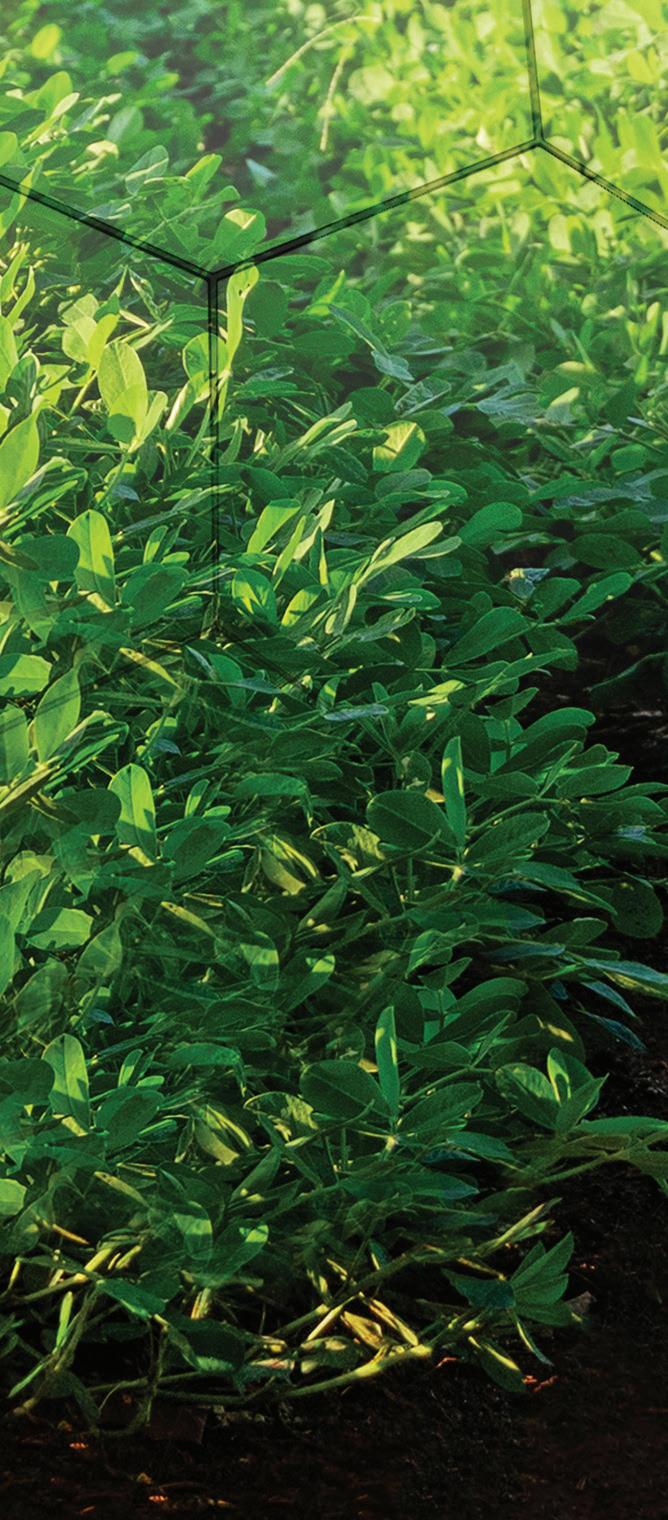



harvested in the state,” Cotton says.
Grouped into the Southwest, Arkansas has become a fairly significant growing area with about 12% of the acres for that region. As well, Missouri has almost the same planted acreage now as Virginia.
Yields were affected by dry weather conditions in many areas of the Peanut Belt. In the Southeast, there were pockets of drought, some of which recovered fairly well.
“The Southeast’s yields were about 6% below last year and below average,” Cotton says. “In October, Georgia was predicted to average 4,300 pounds to the acre, but they fell short of that number by 230 pounds per acre.
“In the Southwest, for the second year in a row and three out of four years, the average has been below 3,000 pounds per acre for Texas. That is a fairly low yield when you consider a state average, but that’s what happens when you have the extent of dry weather and no rain that they have had the past few years.”
The bright spot in the Southwest is just over the state line into Arkansas, which had a tremendous average yield of more than 5,800 pounds to the acre. This is the second year in a row producers have yielded more than 5,000 pounds to the acre on their peanuts.
“In the V-C,” Cotton says, “this was the third year in a row that all three states averaged over 4,000 pounds per acre. In fact, U.S. Department of Agriculture’s National Agricultural Statistics Service says this could be an all-time record yield in Virginia. While the numbers are not finalized yet, it will be in the 4,800-pound range.”
Overall, the U.S. average yield is 3,668 pounds per acre and is the lowest since 2016. The average yield had been forecast at 3,900 pounds per acre in October, so the crop did not come in as well at harvest as was expected at one time.
Overall, the total U.S. crop will be very close to the U.S. demand at 3 million tons. That includes domestic and export demand and represents an 8% increase over last year’s production. Runner production increased by 6% over last year. Both Spanish and Valencia types had an increase in production in 2023, but Virginia-type peanuts declined slightly.
Overall, the total U.S. crop will be very close to the U.S. demand at 3 million tons.
Cotton says the origination of Virginia-type peanuts is returning to the V-C area. “In 2023, 85% of the Virginia’s were produced in the V-C area. Prior to that, 80% were produced in the V-C and before that 77%. The difference is the amount of Virginia peanuts produced in the Southwest where a significant quantity was produced three to four years ago, so these past couple years because of weather, they didn’t make as many as they had been.
“We are stuck on that 1 million tons carryover, and we had a 3-million-ton crop, which is pretty much what demand is, so everything is pretty much staying the same,” he said.
“On the export side, January through October, exports
• U.S. producers planted 15% more peanuts in 2023.
• The average yield is 3,668 pounds per acre, the lowest since 2016.
• Production matches demand with a one-million-ton carryover.
• Seed and chemical prices are unchanged in budgeting; diesel and fertilizer prices are down.
• Acreage shifts are not expected; producers are encouraged to continue rotations.
are up 14%. The top three markets are Mexico, Canada and China.” Cotton says it is a little unusual for China to be buying now because usually they are big players in years with significant quality issues.
“That’s what they want to buy. They want to buy them cheap. With the past two crops being higher quality and this crop that still fairly good quality, it’s good to see they are buying some decent peanuts,” he says.
Clemson University Extension economist Nathan Smith works with a team of researchers to prepare crop budgets for producers to use in their planning. For 2024 budgets, he says they left seed and chemical prices about the same as the previous year. However, one item of good news Smith points out, when comparing this year to last year, is that diesel is down in price a little over 17%. Fertilizer prices are also down, but those had been coming down for much of last year.
“Nitrogen is down somewhere between 25% to 30% when comparing this time last year to now,” Smith says. “But when I say it came down from last year, it actually was coming down since about February last year. So, you had likely already realized that, but it has only recently been changed in our budgets for 2024.
“DAP had been increasing in the last half of 2023. Urea came up from its low last year and is still around 60 cents per pound for nitrogen. Potash has been in the $5.15 to $5.20 range,” he says.
Even though some prices are down, Smith says fertilizer costs are still well above what they were three to four years ago.
In looking at yields, Smith says South Carolina farmers averaged a little over 4,000 pounds per acre in 2023.
“So that’s three years in a row of a little better than two tons of peanuts per acre for a state average,” he says.
As for other crops, and despite a probable record yield in soybeans in 2023 at 39 bushels per acre, what does that mean for crop acres in 2024?
Smith says, “There’s nothing really calling for a change in acres, and we want to maintain our rotations. There will probably be some marginal acres moved from cotton to peanuts in Georgia. I think there will be a small shift there because they planted more, but I don’t see a big shift happening.
“Nationally, the first early survey is showing us about the same on cotton acres. Some options will be weather driven when we get into the spring, especially when it comes to corn verses cotton, peanuts and soybeans.” PG
Nearly everyone agrees that peanuts have a great story to tell. It’s a nutritious food and good source of affordable protein. The crop fits into a rotation with other crops. The water footprint to grow peanuts is much less by far than any tree nuts and has even been reduced by 33% in the past few decades.
more producer involvement,” Randall says. “It does not involve your entire farming operation but instead asks you to map out only about 10% of it.”
For the 2022 crop year, Randall says about 99,000 acres were represented, which is about 7% of total peanut acreage.

Even though these things are known, it’s not the same coming from researchers or promotion boards. Consumers, manufacturers and trading partners are pushing to know more about their food products and to know that it’s grown in a way that is taking care of the environment. But it’s farmers who are critical in the process of explaining how sustainable peanuts are as a food commodity.
“Like the Cotton Trust Protocol, the Sustainable U.S. Peanuts program is a mechanism to gather data and provide it to those who need it while protecting your privacy,” says Allie Randall, American Peanut Council director of sustainability. “We need farmer input. It takes roughly an hour to sit down and input the information about your production practices and its basic information.”
All answers are pooled together as the U.S. peanut industry, and no one has access to individual farmer data.
“To be an accurate representation of the industry, we need


“For this year, we are trying to get to 10% total acres and at least 300 growers,” she says. “It’s easy to do. You can even use your cell phone, and you can work on it a little at a time instead of all in one sitting.

“We are now collecting data on the 2023 crop through April,” she says. “Growers who are already in the Cotton Trust Protocol can join that account with Sustainable U.S. Peanuts to streamline the enrollment process.”
The 2022 crop program highlights include that growers are utilizing good management practices on their farms and 90% of participants:
■ Plant cover crops on some of their fields every year.
■ Work with agronomic advisors for management decisions.
■ Use GPA and other precision application tools to increase resource management efficiency. PG








The best thing I can tell you in 2024, says University of Georgia Extension agronomist Scott Monfort, is “Don’t use 2023 as a measuring stick. Don’t change anything or make any decisions based on 2023.”
That’s what an aberration 2023 was, says Monfort, who encourages farmers to just stay the course with proven practices. Yield and quality took a hit in 2023, but the reasons have little to do with what producers did and more about weather conditions.
Monfort says, for the most part, peanuts can be grown based on recommendations from universities and Extension.
“We know, based on all the research that has been done on peanut, that if the weather does not play a role, about when things will happen,” he says. “If the weather cooperates, we can expect blooming at about 30 to 35 days.”
But it’s that “weather cooperating” part that did not happen in 2023. “We didn’t start to see blooming until 45 to 60 days after planting for a lot of our peanuts,” he says.
“We started off cool and wet in April and May. We couldn’t get planted on time and that pushed our planting date out,” Monfort says. The other problem was low-vigor seed combined with the weather conditions.
“If we had had warm temperatures and a bit of moisture, we probably would not have had problems with the low-vigor seed. But with the cool, wet soils, that did not happen. We had a lot of fields that did not come up very well.”
By June most of the crop was planted and progressing, even if it was a bit behind. However, about the third week of July started a dry spell. “We went through 25 days of no rainfall at 95-plus degree temperatures. Some places didn’t see any rainfall,” Monfort says.
A peanut plant needs 1.7 to 2 inches of water per week when it is in peak bloom and early podfill. The problem for any early planted crop, the water-use curve did not sit where it is supposed to. These plants sat in May and did not grow, physiologically.
“With the water-use curve shifted to the right, peak bloom ended up in the hottest period of the year. At 95 degrees, plants

• Low-vigor seed is more negatively affected by adverse weather conditions.
• Days after planting may not match the physiological progress of the peanut plant.
• The maturity board is a guide, and some years require flexibility in determining digging date.
tend to shut down and not do anything,” he says.
At that temperature, peanut plants are losing 1.8 inches a week in evapotranspiration. They need 2 inches per week during peak bloom and podfill. Is there an irrigation system out there that can put out 4 inches a week, Monfort asks.
“This is one of the reasons why we lost some of our yield. The plant started aborting one of those two peanuts in the pod or they never filled out.”
By September and October, when the crop still needed warm temperatures to get to maturity, the heat tapered off. The amount of immature pods meant grades were also down considerably from the normal range.
“The only way to get the weight and grade is to pull that lagging 50% toward maturity,” Monfort says. “In 2023, that took more than 145 days, and a lot of peanuts were 150 to 160 days old. We had some that went out as far as 180 days.
“When growers started putting pods on the board, and we saw the brown and black up front, folks were saying, ‘They are ready to dig.’ But there were also a lot of immature pods in a second group on the board. We needed to bring that lagging group up.”
Monfort says after the first couple of weeks of maturity board profiles, they tried to get the word out to Extension and farmers that whatever the board says, add 10 to 20 more days. “The board is a guide, and this year showed us that sometimes we need to be flexible in determining when to dig.”
While there is much to learn from a difficult crop, it doesn’t mean growers should do anything different for 2024. PG













With EXCEED® brand inoculants you can always count on quality, reliable products at a great price with exceptional service.




Exceed® SAR for Peanuts. MORE than just a seed inoculant.

The EPA Registered SAR Component:
• Provides protection against fungal infections such as damping-off and white mold
• Interrupts the life-cycle of the root-knot nematode
• Elicits the plant enzymes for vitality
6100
6000
5900
5800
6200 Yield (Lbs/A) Exceed SAR
5915
South Georgia2021 & 2022 (2-Year Average) +562 Lbs/A Above Control 4000
5000
4800
4600
4400
EXCEED® SAR INOCULANT TRIALS 5700
6151 Competitor
4200
North Carolina2022 (1-Year Average)
5200 Yield (Lbs/A) Exceed SAR
5143 Competitor 2
5008
•Elevates the innate immunity defense mechanism of the plant
• Boosts germination and builds a stronger root system
•Increases yield - trial results show an average increase of 434 pounds per acre
4864 Control

4581 Competitor 1



To learn more, contact your local dealer today.

Drought continues to linger in patches of the state, but Texas agricultural producers face much better cropping outlooks going into spring says Texas A&M AgriLife Extension Service experts.
In late September 2023, about 97% of the state was experiencing some level of drought, with two-thirds of Texas mired in severe-to-exceptional drought, according to the U.S. Drought Monitor. As of Jan. 16, 2024, that figure had dropped to 58% of the state experiencing levels of drought with about 13% experiencing severe to extreme drought and zero areas reporting exceptional drought.
John Nielsen-Gammon, Texas state climatologist and professor in the TAMU Department of Atmospheric Sciences, Bryan-College Station, says multiple storm systems could
deliver needed moisture in areas like Central and East Texas that remain abnormally dry.
“About half the state has decent moisture, another 20% that is abnormally dry, so that leaves about one-third of the state, like Far West Texas, southern parts of the state and pockets in North and East Texas dealing with drought,” he says. However, the long-term outlook is not as promising.
All six climate models, run by weather agencies like the National Oceanic and Atmospheric Administration, show Texas will be drier than normal in late spring, which is the peak rainy season for most of the state.
“Having all six models forecasting the same outcome tells me
there is a strong likelihood it plays out that way,” NielsenGammon says. “It doesn’t mean bone dry. It just means less rain than we receive during the months that rainfall typically peaks.
Even so, Texas farmers should be more optimistic at this point says Ronnie Schnell, AgriLife Extension agronomist in Bryan-College Station.
“Input prices have fallen somewhat, but so have market prices, so plan ahead to optimize fertility and control weed and insect pests to give the crop the best chance possible for yield,” Schnell says. “Last year was very dry, but areas of South and Central Texas had the best corn in years. Sometimes that drier pattern, if we get timely rains, can change an outlook quickly.”
It would be ideal for soil moisture to improve going into planting, they said, adding they hope growers are able to take advantage of available moisture, plant as early as possible and manage their crops efficiently and effectively.
Despite two years of consecutive drought, peanut production was increased in 2023 compared to the year before.
“This past year’s peanut growing season was a roller coaster,” Matt Boerner, Cooke County peanut farmer says. “We started with wet conditions and a good stand for the crop, and then we moved into a dry and hot summer. We received rainfall later in the season, but with cooler temperatures and less sunlight, it was too late for the crop to produce.”
Texas production is forecast at 656 million pounds, according to the November U.S. Department of Agriculture National Agriculture Statistics Service report. Peanut yield is expected to reach 3,200 pounds per acre, up 400 pounds over 2022.
Although 205,000 acres of peanuts were expected to be harvested, Texas AgriLife Extension state peanut specialist Emi Kimura says the report does not fully depict the 2023 growing season. Almost 14,000 acres were lost to dry, hot conditions, she says. Farmers who were able to irrigate through the drought were able to maintain good pod and peanut development. However, those who were not able to keep up with moisture demands suffered another rough year.
Kimura says drought delayed crop progress, and weather-related events delayed harvest as well.
“Producers waited a week or two longer than normal to harvest their crop since the rain we received in May and June pushed back planting,” Kimura says. “The drought also slowed down production, so waiting to harvest allowed the crop to mature.”
“With having back-to-back years of drought, we hope to have a different story this year,” Boerner says. “We hope to see more rain, greater demand and market prices that are competitive with the cost of inputs.” PG
Portions of this article by Shelby Shank, Texas Farm Bureau field editor, and Adam Russell, communication specialist for Texas A&M AgriLife.




Todd Baughman will return to Texas to serve as director of the Texas A&M AgriLife Research and Extension Center at Lubbock. He will begin April 1, replacing longtime director Jaroy Moore, who is retiring.

“We are very pleased to have Dr. Baughman return to Texas A&M and lead our research efforts at Lubbock,” says G. Cliff Lamb, director of Texas A&M AgriLife Research. “His leadership will be critical as the center works to strengthen agricultural systems and economies in the South Plains and address key agricultural issues through innovative research.”
Baughman previously served as Texas Extension service crop production specialist and statewide peanut specialist from 1996 to 2011 in the Rolling Plains before joining Oklahoma State University as a professor and weed scientist.
In taking the leadership role at the center, Baughman says his priorities will be the continued development of research and Extension programs that support the agricultural industry in the Southern High Plains and ensure the success and viability of producers and agricultural industry in that region.
Being in the center of the world’s largest cotton patch, Baughman says that commodity is obviously at the forefront of needs. However, water is also a major concern, whether that is irrigation, rainfall or water conservation.
“Water management is a priority for our faculty and programs,” he says. “We have significant dryland acreage, and we need to be able to help those producers manage water as a resource as well as help those who use water for irrigation.”
Other crops in the region – peanuts, corn, grain sorghum and wheat – will also be the subject of continued research.
“I’m very excited to be able to work with the outstanding faculty located at the center and be able to help them achieve their goals,” he says.
Baughman, a native of Cache, Oklahoma, earned his doctorate in weed science from Mississippi State University, and his master’s and bachelor’s degrees in agronomy from Oklahoma State University. He is currently president of the Southern Weed Science Society, a member of the Weed Science Society of America and an American Peanut Research and Education Society Fellow. PG
As unpredictable as peanuts can be, it’s a relief to have options with planting fast approaching. “We’ll probably be planting sometime in May,” says Eddie Polin, peanut grower in Cameron, South Carolina. “Obviously early season pest management is our primary concern starting with nematodes before the plant even emerges.”
As important as pest management factors into overall crop management, Polin also pays a lot of attention to how the plant comes out of the ground. According to him, he gets an extra boost when he uses AgLogic 15GG aldicarb at planting.
“I want to start off watching those peanuts grow, and I mean grow like crazy,” he says. “I know what’s coming. It’s thrips. I also know what’s already there, and even with a good rotation program, it’s nematodes to a certain level. Not only does AgLogic do a good job of keeping those pests under control, but there is also something about that product that kickstarts the crop. You can see it from the moment the plants emerge.”
Nematodes are an issue regardless of the crop he’s growing, and it’s not just one species. “You name it, we’ve probably got it,” he says. “Reniform, root-knot, lance and sting – just to name a few. Rotation helps, but it doesn’t entirely solve the problem.”
Polin says the years that aldicarb was unavailable in the market turned a spotlight on the long-term nematode benefit of AgLogic over multiple years and multiple crops.
“If you lose a product like that, you’re going to notice it eventually,” he says. “You might get by with other products, seed treatments or combinations of strategies for other pests, but unless you have a truckload of money for fumigants in the nematode arena, you’re going to notice aldicarb when it’s gone.
“Nematodes are incredibly persistent over time,” he continued. “They also tend to be an ‘out of sight, out of mind’ type of problem. If it’s root-knot, you might have more visual clues and readily notice it’s a problem. On the other hand, if it’s reniform, it’s more likely to sneak up on you getting worse year after year.”
It was his use of AgLogic in cotton that inadvertently drove his use of the product on peanuts in 2020.
“We had some AgLogic left over in the hopper after planting
cotton when we were going back to replant some peanuts,” he says. “After I made sure I could go ahead and use it on peanuts, I made the decision to just keep going. That year was an eye-opener. The peanuts came screaming out of the ground. Since they were already late due to re-planting, that was a tremendous advantage that year.”
The leftover product that Polin was able to use on peanuts further opened his eyes to the importance of maintaining options. Having worked in multiple aspects of the ag industry from scouting to chemical and seed sales, he has a broad perspective of the impact of product availability.
“Everything I’ve done has led me back to farming,” he says. “I love the job and try not to take anything for granted about it. It’s definitely not an easy one.”
In regard to availability, it’s a complicated situation, but worth keeping an eye on, he says.
“As a grower, I want to be assured as much as possible that I have access to a number of options when I’m ready to use a product for whatever problem I have in my crop. I think one of the keys is having a strategic plan prepared as soon as possible. Last-minute decisions are never a good idea if you have the ability to plan ahead,” Polin says.
AgLogic’s performance in peanuts wasn’t much of a surprise to Polin. He already had years of experience with AgLogic in cotton.
“Cotton is a crop that gets eaten in every direction,” he says. “Above ground, the fruit is very susceptible to early season pests such as thrips, and below ground we get hit with a whole range of nematodes. In some ways it’s not much different than peanuts. You’re going to get hit below and above ground.”
Polin uses AgLogic on all of his cotton acreage. Last season, Polin planted DP 2038 and the nematode-resistant variety DeltaPine 2141 with root-knot nematode and reniform nematode protection.
“Even with built-in nematode resistance in a cotton variety, AgLogic gives the plant that added nematode protection,” he says. “When you combine that with the thrips control, you’re getting protection above and below on multiple fronts. It sure helps with peace of mind when the crop is arguably at its most vulnerable point.”
Polin also planted part of his cotton acreage to DP 2038 and used AgLogic on it.
“Across the board, the cotton averaged 2,157 pounds per
acre last season,” he says. “And that was dryland. I’ll definitely take that any day. Of course, we had some good luck in terms of weather. We got rain when we needed it for one thing, but a lot of luck is just having everything set up in advance to take advantage of it.”
While AgLogic is credited with providing early season pest control, its impact can be seen all the way to harvest regardless of the crop, according to Polin. It’s more than


just early pest protection that makes a difference. He credits the additional factor of early season vigor.
“Sure, we’re getting the measurable benefits of pest control and nematode suppression, but it’s also that early vigor that stands out in the beginning and yields results at the end – no matter if it’s peanuts or cotton,” he says. “You can see it from the beginning and unless something goes terribly wrong that is beyond control, you can take it to the bank.” PG
Article by Brenda Carol on behalf of AgLogic.

 Cameron, South Carolina, peanut grower Eddie Polin
Cameron, South Carolina, peanut grower Eddie Polin



The 2023 growing season was another hot and dry year in Texas. Having one drought year is tough enough, but two consecutive years of drought made our lives very difficult. Under such challenging environmental conditions and ever-increasing input costs, growers will need to spend every single dollar in the most efficient way to improve yield potential. Fundamental agronomic practices can assist in important decision making for profitable peanut production.
Although peanuts are relatively easy to establish as compared to cotton due to the larger seed size, we want to make sure the seeds are planted at the right time. Understanding the top four inches of soil temperature is critical to determine the best time for peanut planting. Optimum soil temperature for peanut germination is at least 68 degrees

Fahrenheit for three consecutive days without a cold front in the forecast.
In Seminole, Texas, this can be achieved after May 1, based on past weather data. The average soil temperature in the past 10 years has been above 68.8 F after this date. In contrast, soil temperatures in the last week of April have been highly variable. The range of soil temperatures during the last week of April in 2023, five-year average and 10-year average were 58 to 72 degrees, 67.6 to 71.2 degrees and 67.6 to 76.2 degrees, respectively. Cold snaps and dry soil conditions can slow germination of peanut and cotton. The longer seeds stay in the soil, the more susceptible they become to soilborne and seedling diseases.
Before making planting decisions, check current soil temperatures for your area online at West Texas Mesonet database at https://mesonet.ttu.edu/latest-sobs. Establishment of a good stand is the first step for successful peanut production for the 2024 growing season.
We often see our most important challenges as the ones we experienced most recently, and in particular what happened in last year’s crop. How often does that issue translate into the growing season that is just around the corner? We probably know the answer, or at least mine would be, not all that often. But, we will do things to keep that problem from being a problem again regardless of how often it will happen.

Of course, some things are relatively constant. In the V-C region, we know each year we have predictable populations of weeds in our fields, and that we will have significant injury from thrips if we don’t apply insecticide when we plant. We also know that response to soil acidity (pH), fertilizer and inoculants for nitrogen fixation is consistent from year to year. Of course, leaf spot is a common denominator, and we know digging date matters.
On the other hand, the presence of certain pests and a positive return on some practices are less predictable going into the season. We know that some factors — soil characteristics, weather patterns, planting dates and varieties — create greater risk than others. However, we don’t know exactly how the season will play out until it happens.
2023 was a unique season for peanut production. May and early June were about as cold as most folks can remember.



We had a cool snap in late September that delayed or stopped further pod maturation, and then October seemed cooler than the new normal followed by a hard freeze on Nov. 2 in the upper V-C region. All of this occurred with the backdrop of the warmest year on record worldwide, according to some measures. It seemed like for about a decade, temperatures in September were about like August. But in two of the past three growing seasons, we had a cool snap around Sept. 20 that slowed the pace of pod maturity in a major way.
Large swings in weather from year-to-year and regionto-region are a part of the new norm. And those swings are related to a planet that has experienced changes in climate that are less predictable, with more extremes, due in large part to a warming planet. This brings in more risk to our production of peanuts because of the unpredictable nature of our growing seasons. A big question is, can we successfully manage our crop knowing that some of the principles we have relied on in the past are likely to be less effective or at least less effective at times than they used to be? For example, when will pests become more of an issue in the cropping cycle? How does planting date play into that estimation? These two questions have always played a major role in our decision-making process, but there seems to be more unknowns because of the unpredictable weather now than in the past.
It is more important than ever before to consider the risks of each practice we put in place and think about what we need to do from a preventive standpoint versus what we can do from a reactive standpoint. What flexibility do we have to minimize the adverse effect of each challenge that comes our way? I’ve got more questions than answers in this column. Hopefully, over the next few months, I’ll be
able to present ideas on practices that can help minimize risk to yield with the unknowns we have.
With that said, right now we can work toward getting soil pH across each field up to 6.0 with no areas less than 5.8. We can use our soil test reports to apply fertilizers at the right rate across the entire field. Regardless of our tillage system, we can do things proactively to make sure peanuts are weed-free when they emerge. And, we can select systemic insecticides that are effective against thrips, and apply inoculant for nitrogen fixation when we plant, regardless of rotation history. Irrespective of weather patterns, these practices will bring home a positive return on investment.

The 2024 planting season is just around the corner, and growers have a lot to consider. Initial conversations at grower meetings are pointing to a potential increase in peanut acreage in Georgia. An increase in acreage will cause growers to reduce their rotation interval between peanut crops on some farms, along with planting more acreage in April and early May. With this in mind, growers are encouraged to consider all risks associated with these management decisions.
Growers can produce high-yielding peanuts under shorter rotation and earlier planting as long as they construct a good management strategy ahead of time. The initial part of this strategy should always include soil sampling to eliminate fertility and soil pH issues ahead of planting. Also, it is important to consider where you are planning to plant peanut and which of these fields/farms are more suited for planting early (well drained, etc). For example, low-lying fields or reduced-tillage fields with cover may not be well suited for early planting as they will remain cooler and wetter longer, which may promote seedling disease issues. The University of Georgia Extension service recommends planting in soil temperatures of 68 degrees or higher to allow for adequate germination and emergence.
Tomato Spotted Wilt Virus is also a factor for which growers need to plan. TSWV has been a recurring problem for the past several years, and it is expected to be a problem for growers in 2024. Growers can contact their local county



Extension agent to discuss options to minimize potential TSWV and seedling disease. County agents can help direct you to the best varieties to plant, most effective insecticide to control thrips and lower TSWV risk as well as extra fungicide options as needed.

Looking back over this past crop season, there was ample rainfall early in the season then during the month of June. In July, the rainfall dried up and then vanished for the remainder of the growing season throughout the southern region of the state. It isn’t that uncommon for the southeastern part of the state to have dry pockets during the late growing season. However, it is unusual for the southwest part of the state to be as dry as it was during July, August and September.
Dry weather wasn’t the only issue. We had three weeks of 100-degree temperatures that plagued the lower half of the state from east to west. Coupled with the lack of rainfall, these conditions took a toll on Alabama’s peanut crop. These adverse conditions made yield plummet to an estimated 2,700 to 2,800 pounds per acre. We haven’t been below 3,000 pounds per acre for a state average in several years.
The dry weather also affected crop grades, which affects what farmers are paid per ton. The dry weather caused peanut plants to abort some kernels creating pops. Lack of moisture prevented some pods from fully maturing. The immature kernels caused reduced total sound mature kernels and increased the percentage of hulls, which both decreased the grade and the price per ton received by the producer.
As a reminder, look at variety trials across the state not only for grades but also yields. You may see some varieties at the top of tests that haven’t been there. There may be new varieties or some that have been around for a while. I would encourage you to dig into the data and see what enabled some of these different varieties to outperform the traditional workhorse varieties this past season. For instance, pay attention not only to yield but disease counts. Some may have looked better due to the lack of late rainfall, which led to less late leaf spot.





In its 20+ year history,
the National Peanut Board has invested and secured more than research funding, through budgeted allocations and industry matching funds.
�48.5 million